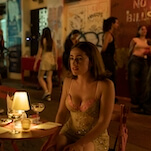I actually rewatched Despair yesterday. It’s from 1978, one of the last films that Ballhaus shot for Fassbinder, a kind of perverted prestige project: an English-language adaptation of one of Vladimir Nabokov’s early Russian-language novels, with a script by Tom Stoppard (one of his first), purple Futura opening titles, and a color palette largely reduced to cadaver tones and the occasional splash of mauve. The novel is something of a Dostoevsky parody. A Berlin chocolatier (played in the film by Dirk Bogarde) commits what he believes to be a perfect crime, faking his death by killing a stranger whom be believes to be a perfect double—except the resemblance between the two men is lost on everyone else. Nabokov was a true aesthete of the written word, and the tricky delusions of his prose can never really translate to film. But Despair, for all of its serious flaws, at least approximates a twisted worldview by imagining 1920s Berlin as an art deco crypt where everyone behaves like some kind of creep.
Strangely, or perhaps fittingly, it features some of the most classically elegant camerawork to come out of the Ballhaus-Fassbinder partnership. Ballhaus had a large but very specific vocabulary: dolly shots that trace circles; faces reflected and distorted in shiny surfaces and mirrors or sectioned off into a close-up frame within the frame; heads cropped off at the corner; close-ups of small objects that imply some relationship to the out-of-focus background; faces cut by light passing through blinds; elaborately choreographed long takes. What all of these Ballhaus-isms have in common is that they turn the camera into the main dramatic actor. The feeling of the shot—it isn’t in the actor’s face, but in the speed with which the camera slams into it and the angle of its attack. This reaches its mature form in his collaborations with Martin Scorsese, but it all starts with Fassbinder.
The slat cucoloris pattern that he uses for Willem Dafoe’s fair-haired Jesus several times in The Last Temptation Of Christ, for example, is first seen in its experimental form in glamor shots of men of color in Fassbinder movies: El Hedi Ben Salem in Ali: Fear Eats The Soul and Günther Kaufmann in The Marriage Of Maria Braun. (Both actors were romantically involved with Fassbinder, so there is something irresistible in a cinematographer translating one director’s erotic fascination into another’s religious longing.) Though oddly enough, the real Rosetta stones of the Ballhaus-Fassbinder-Scorsese line—which also includes Francis Ford Coppola’s Bram Stoker’s Dracula—are projects made for West German TV, including Martha and the two-part World On A Wire. The latter contains some of the most ingenious and bizarre cinematography of the early part of Ballhaus’ career.
Other viewings: I found myself sucked into Win It All, Joe Swanberg’s modest but very likable drama about a compulsive gambler. It’s a shame that the film is being distributed exclusively to Netflix, because it strikes me as his prettiest film. It’s the next step in an embrace of conscious and conspicuous craftsmanship—in terms of camerawork, narrative structure, and the use of music—by a filmmaker who started out as a complete anti-aesthete. In addition, I award it bonus points for its extensive and accurate use of Chicago alleyways.








































